With more than 6,000 known species of incredible-looking frogs and more being discovered all the time, it can be tricky narrowing down the most adorable of the bunch. Still, we’ve managed to find 10 of the cutest frogs in the world and have listed them below, along with some fun facts about each respective species!
Read on to learn more about these funky, unique, cute, and striking frogs and why we love them so much.
1. Budgett’s Frog (Lepidobatrachus laevis)

The Budgett’s frog’s huge mouth and bulging eyes make it strangely adorable
©Milan Zygmunt/Shutterstock.com
To some, the Budgett’s frog likely falls squarely into “ugly cute” territory, but we can’t get enough of this goofy, absurdly wide-mouthed, beady-eyed amphibian. In addition to their rather unusual appearance, Budgett’s frogs are notable for their high-pitched, screeching vocalizations. When threatened by potential predators, they will inflate their bodies while “screaming” at them and backing away to make themselves look (and sound) more intimidating!
Budgett’s frogs are highly aquatic and are native to South American countries like Argentina, Bolivia, and Paraguay. Due to their relatively small size and hardiness, they have also become very popular in the pet trade. Just make sure not to cohabitate these frogs with anything smaller than they are! They commonly will eat just about anything they can fit into their gigantic mouths. Their teeth are also surprisingly sharp, so be careful while handling them.
2. Amazon Milk Frog (Trachycephalus resinifictrix)
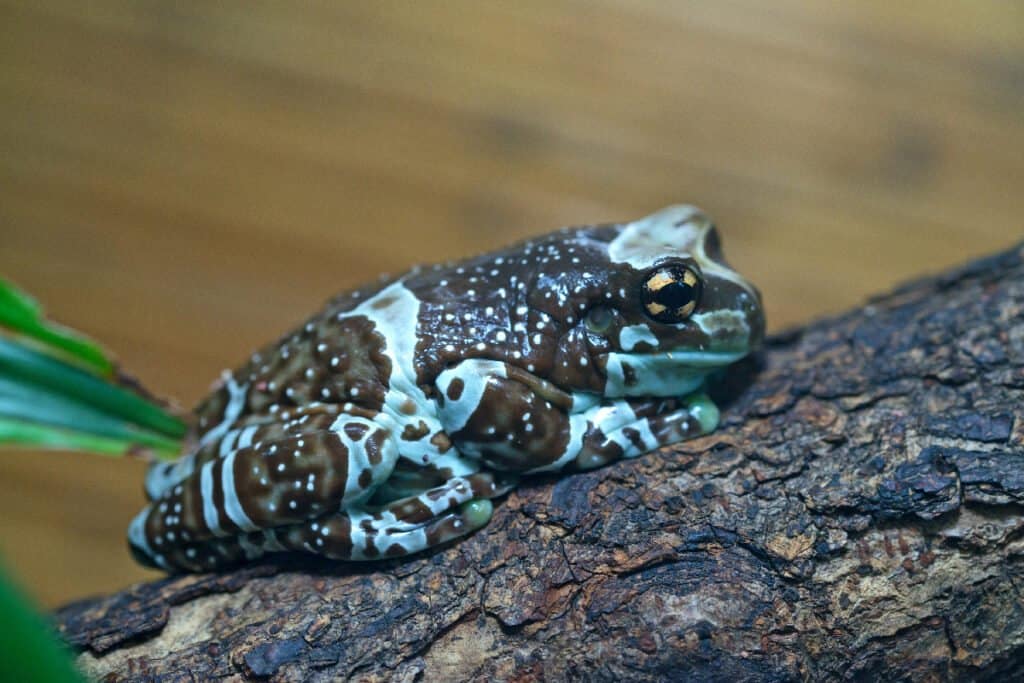
The Amazon milk frog’s coloration and large eyes make it look very cute
©iStock.com/Oskanov
The Amazon milk frog is as cute as it is colorful with its bluish-green and brown splotches, wide eyes with cross-shaped pupils, and large, squishy webbed toes. It is also commonly known as the Mission golden-eyed tree frog and the blue milk frog. Interestingly, the “milk” part of its name comes from the cloudy white substance their skin secretes when they feel threatened.
Native to warm, wet rainforests throughout the Amazon, milk frogs are small, shy, and rather reclusive. They are nocturnal and highly arboreal, preferring to hide amongst the tall trees in their native habitat during the day. At night, they climb down from the trees to hunt for small insects.
In recent years, they’ve become quite popular pets, though their care requirements are tricky for some beginners to manage. They need decently-sized enclosures to keep from getting stressed, and they must be housed in high humidity conditions to stay healthy.
3. Tomato Frog (Dyscophus antongilii, guineti, and insularis)
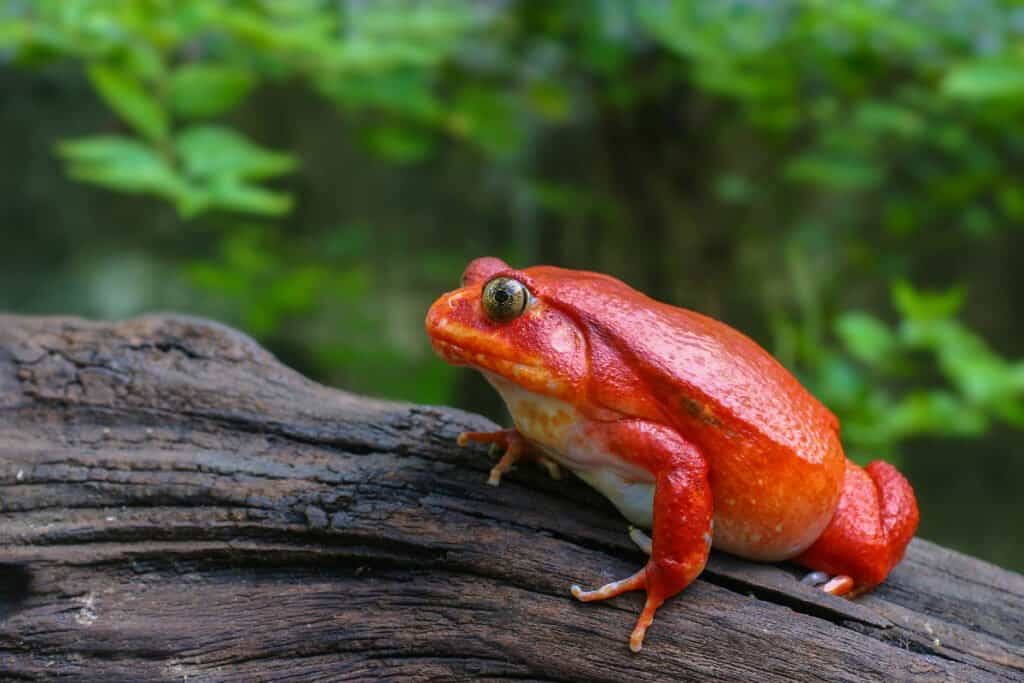
Tomato frogs’ funny little faces have made them increasingly popular pets
©Krisda Ponchaipulltawee/Shutterstock.com
The tomato frog’s name comes from its bright red and orange coloration and round, fat body. These little guys seem to always look as if you’ve caught them by surprise, with their beady yet bulging eyes constantly giving them an alert and slightly perturbed expression. Like many other frogs, they are able to greatly inflate their bodies when threatened to ward off predators. Despite this defense mechanism, though, tomato frogs look far more silly than scary.
Native to Madagascar, the tomato frog has become a popular pet in recent years all over the world. They’re small, hardy, and breed easily in captivity, making them great for beginner exotic pet owners. There are actually three separate species of tomato frogs within their subfamily, Dyscophinae, but they only differ slightly in color.
4. Desert Rain Frog (Breviceps macrops)

These round, chubby frogs recently went viral for their high-pitched calls and grumpy yet cute expressions
©Bildagentur Zoonar GmbH/Shutterstock.com
The desert rain frog has enjoyed much viral fame in the past decade or so! This is mostly due to its adorable, chubby appearance and defensive screech that sounds more like a squeaky toy than a frog. These teeny-tiny narrow-mouthed frogs live along southern Africa’s coastlines, usually staying burrowed in the sand to avoid predators. As nocturnal frogs, they sleep and hide during the day and emerge from their sandy burrows at night to search for insects.
Adding to its cute and silly features, desert rain frogs’ legs are so stubby that they aren’t able to hop very well. Instead, they awkwardly shamble about on the sand until they need to bury themselves once more for safety. Though their legs aren’t very strong, their feet are perfect for digging in moist sand.
Desert rain frogs can make good pets, but they are fairly rare and not bred often in captivity. Their populations are also decreasing in the wild due to habitat loss and deforestation. Sadly, these two factors make these precious little frogs hard to find from exotic pet breeders.
5. Australian Green Tree Frog (Ranoidea caerulea)
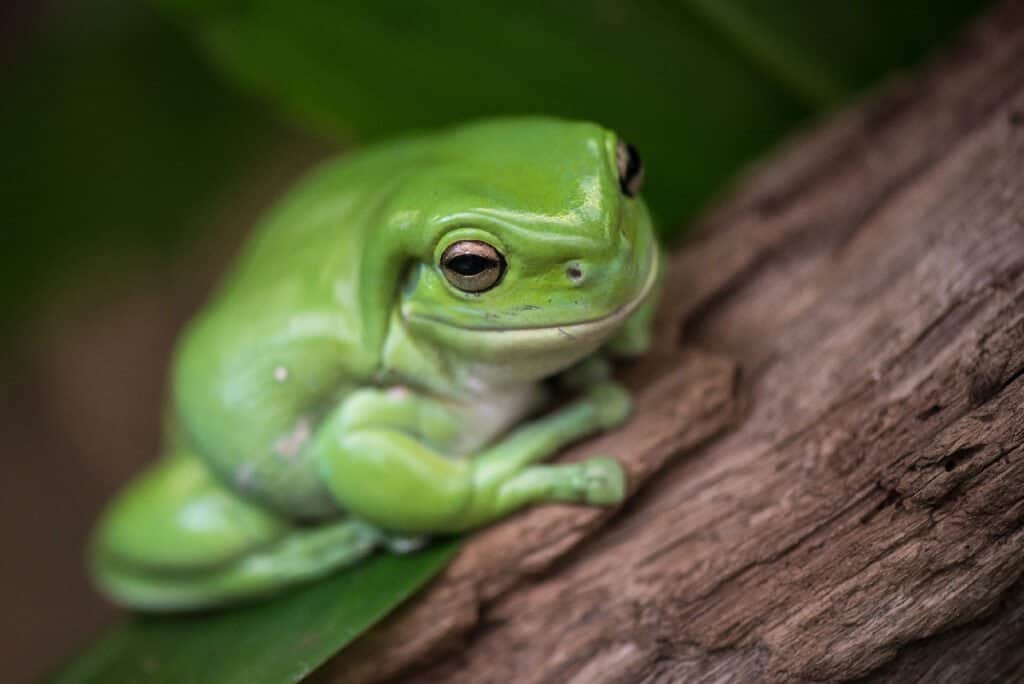
These bright green frogs are some of the most popular exotic pets in the world
©iStock.com/Jennifer Sophie
The Australian green tree frog has many common names, such as the White’s tree frog, the green tree frog, and, amusingly, the dumpy tree frog. Despite this somewhat insulting name, these frogs aren’t “dumpy” at all but incredibly cute, with their large eyes, perpetually smiling faces, bright green color, and chubby, round bodies. As the source of the hilarious “polite frog” internet meme (which is, oddly enough, a spinoff of sorts of the “polite cat” meme), the green tree frog has a pleasant yet silly appearance that perfectly matches its calm temperament.
Although they are native to Australia and New Guinea, Australian green tree frogs have become one of the most popular and well-known pet frogs on the planet. Their care requirements are easy to meet, and the frogs themselves are mild-mannered, curious, and active.
Incredibly, they’ve even been used heavily in various kinds of scientific research, from HIV treatments to fighting the deadly chytrid fungus that has wiped out thousands of frogs all over the world. In fact, the frogs’ skin secretes a substance that seems to protect them from the deadly fungi.
6. Black Rain Frog (Breviceps fuscus)
The black rain frog’s appearance is both striking and amusing, mostly thanks to its constant frown, round, fat body, and extremely stubby legs. These tiny frogs have also enjoyed a small amount of internet fame for their meme-able, highly expressive faces. Like some of the other short-limbed, chubby anurans on this list, black rain frogs aren’t able to hop very well and simply awkwardly crawl from place to place instead.
Even at a glance, it’s easy to see how these frogs are related to the aforementioned desert rain frog! They are both members of the Brevicipitidae family, which consists of various other small, round, narrow-mouthed rain frogs. Black rain frogs are also native to southern Africa’s coastlines, as their shovel-like feet are well-suited to digging in the warm, wet sand.
Another undeniably cute feature of these frogs is their high-pitched call that is somewhere between a chirp and a screech. When threatened, the frogs will inflate their bodies while shrieking and backing away to make themselves look more intimidating.
7. Cranwell’s Horned Frog/Pacman Frog (Ceratophrys cranwelli)

Pacman frogs are very low-maintenance pets, and their unique appearance has made them quite popular
©Valt Ahyppo/Shutterstock.com
If you’ve never heard of this species’ primary name, you’re definitely not alone. The Cranwell’s horned frog is much more widely known simply as the Pacman frog. This is mostly thanks to its large, wide mouth that makes up more than a third of its entire body!
These mostly terrestrial, burrowing frogs are ravenous eaters that commonly hunt other, smaller frogs in the wild. Their bite is surprisingly powerful for their size, so they are able to take down rather large prey with ease.
Despite this not-so-cute behavior, Pacman frogs have become one of the most popular species in the pet trade. Their care is very inexpensive and simple, even for total beginner exotic pet lovers. However, if you do adopt one of these frogs, you may be surprised by how inactive they are, rarely moving from their moist burrows except to eat and defecate. Still, we love these pudgy little amphibians, and we can’t recommend them more as pets!
8. Red-Eyed Tree Frog (Agalychnis callidryas)
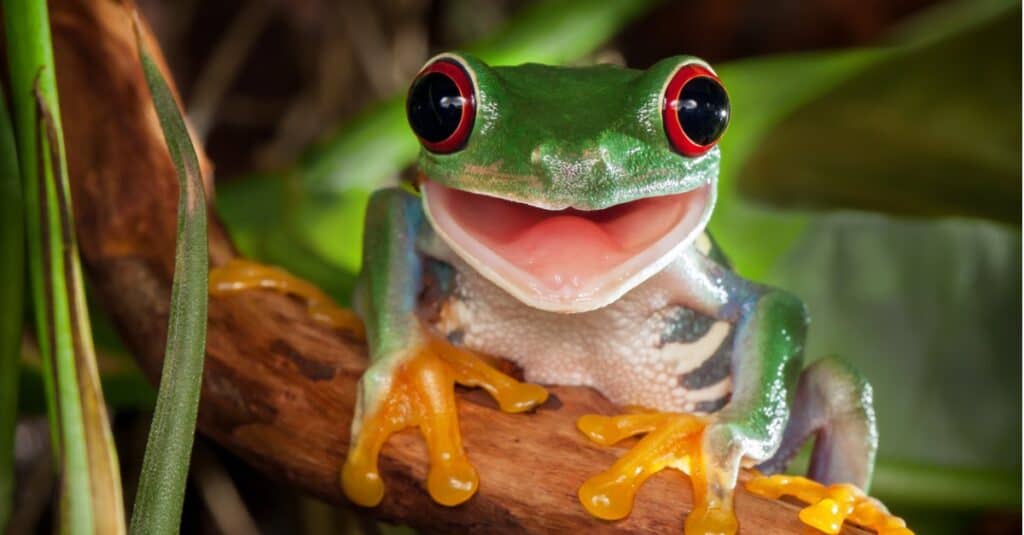
Despite their striking red eyes, these green tree frogs have very cute, expressive faces.
©iStock.com/Linas Toleikis
Even though their bulging, red eyes can be a bit offputting for some, these frogs’ grinning faces and stunning coloration totally make up for it. These small, lean arboreal frogs have mostly green bodies, with blue legs and undersides and bright orange feet. Part of their scientific name actually comes from the Greek word for “beautiful,” kalos!
Native to the warm, humid, dense rainforests throughout South and Central America, green tree frogs are extremely agile at jumping, climbing, and swimming. Combining this trait with their massive red eyes, they are able to ward off predators quite well. They mostly stay quiet and camouflaged amongst the bright leaves and trees, but if a predator comes near, they will quickly open and bulge their eyes at the animal in hopes of scaring them off.
9. Desert Spadefoot Toad (Notaden nichollsi)
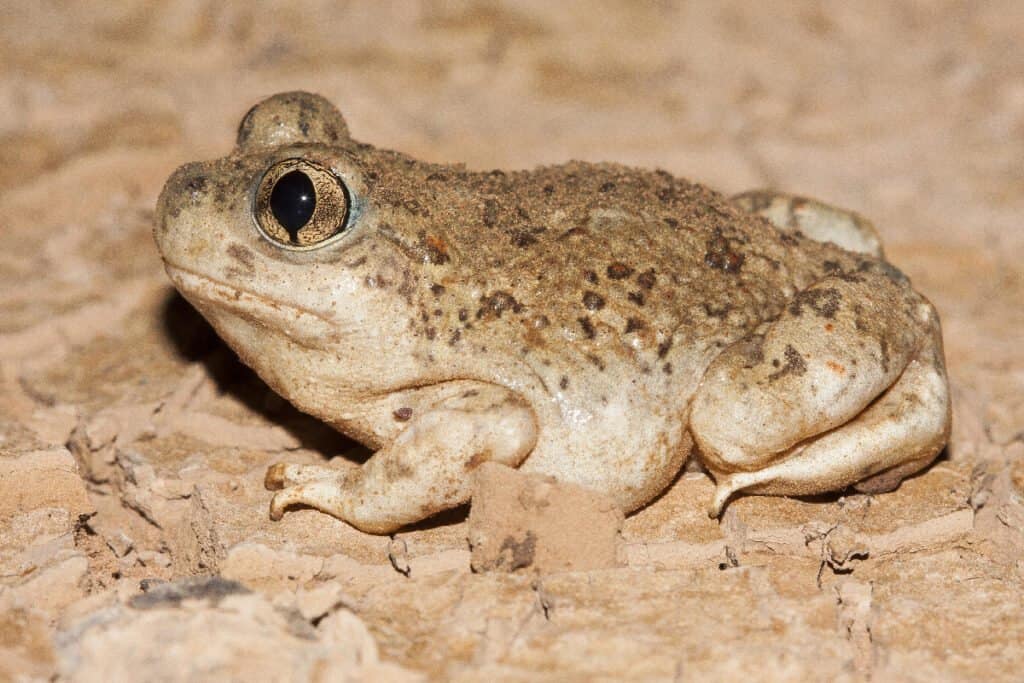
Desert spadefoot toads blend in well with the sand in their native habitats, but if you can find one, they are a delight to observe
©Viktor Loki/Shutterstock.com
There are plenty of adorable spadefoot toads that we could’ve put on this list, but the desert spadefoot is perhaps the cutest! And before you ask–yes, all toads are technically frogs (but not necessarily vice versa). Native to the Australian Outback, these pudgy little guys actually love the harsh, hot, sandy conditions.
For starters, their stubby legs and spade-like feet are perfect for burrowing, allowing the frogs to hide their bodies in the sand when predators approach. They are commonly found with just their heads and bulging black eyes sticking out of the sand, and their tan-colored bodies blend in seamlessly. When insects unknowingly wander past them, they briefly emerge from their burrow, snapping at the bugs and pulling them into their mouths before shuffling back into the sandy depths.
Like other narrow-mouthed frogs, desert spadefoots have a delightfully silly appearance, with their expression constantly frozen in a sad, little frown.
10. Diane’s Bare-Hearted Glass Frog (Hyalinobatrachium dianae)
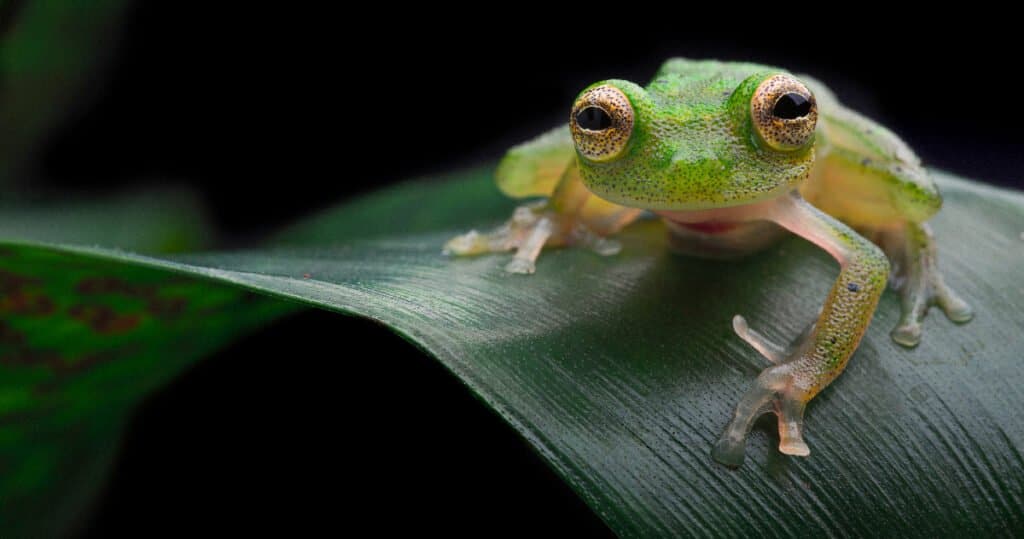
Though its transparent skin is a bit spooky, the bare-hearted glass frog looks a lot like Kermit the Frog!
©Dirk Ercken/Shutterstock.com
Glass frogs in general are visually stunning thanks to their bright coloration and partially transparent skin, but they are also quite adorable! In fact, these cute frogs are commonly referred to as “Kermit frogs” for their striking resemblance to the lovable muppet. Their official name refers to the frogs’ see-through skin on their bellies, which exposes their hearts and surrounding viscera.
Notably, researchers only discovered the bare-hearted glass frog in 2015 in Costa Rica’s Talamanca Mountains. One of the researchers named the frog after his mother, Diane. News of the frog’s discovery quickly went viral, mostly thanks to the species’ cartoonish expression and beautiful colors. In the coming years, we’ll likely learn a lot more about this frog, but for now, they aren’t very well-understood.
Up Next
The photo featured at the top of this post is © iStock.com/Linas Toleikis
Thank you for reading! Have some feedback for us? Contact the AZ Animals editorial team.






